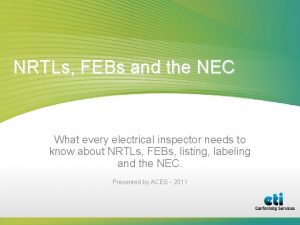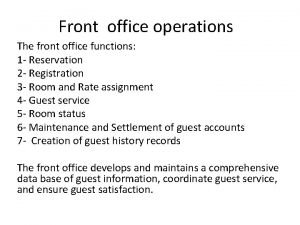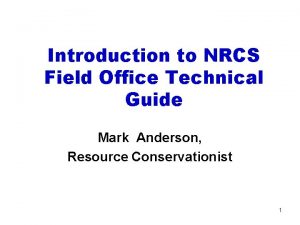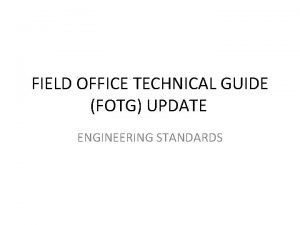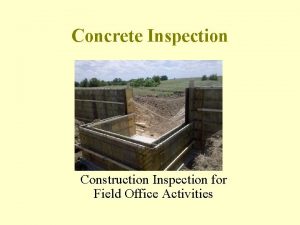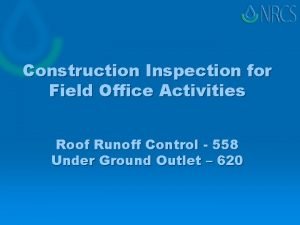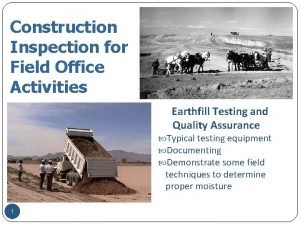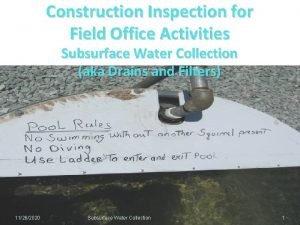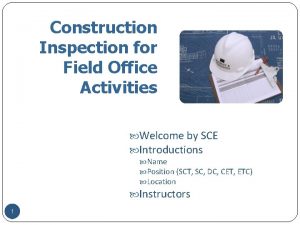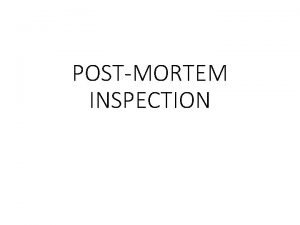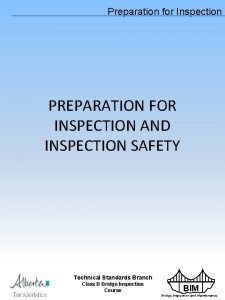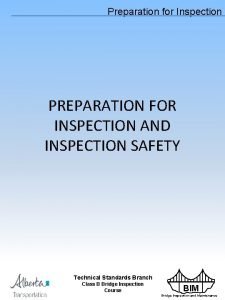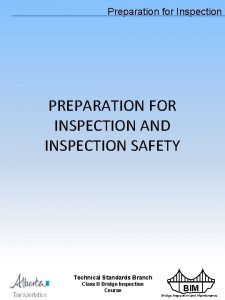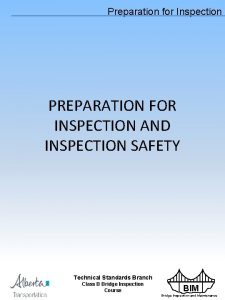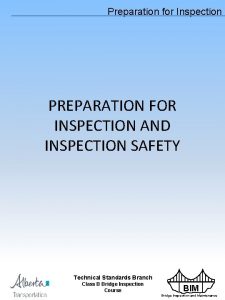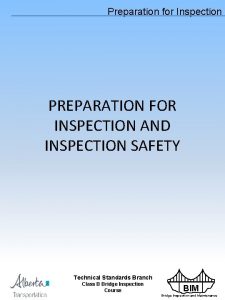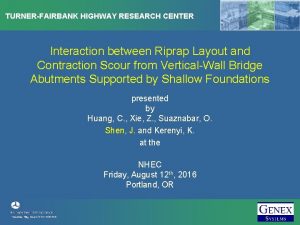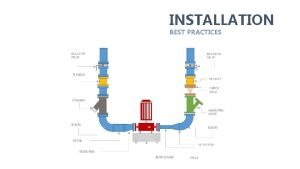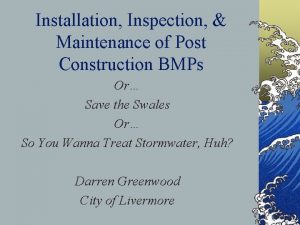Riprap Installation Construction Inspection for Field Office Activities































































- Slides: 63

Riprap Installation Construction Inspection for Field Office Activities Will use Riprap Gradation and Riprap Subgrade Problems from Class Problem Section USDA is an equal opportunity provider and employer.

Objectives Ø Understand importance of rock quality Ø Define D 50, Dmax and Dmin Ø Understand importance of subgrade Ø Visualize good placement vs. bad

Specifications Ø Construction Specification 61 - Rock Riprap Ø Construction Specification 62 - Grouted Rock Riprap Ø Material Specification 523 - Rock For Riprap

Riprap definition Stone materials, generally less than two tons in weight, specially selected and graded, and when properly placed prevents erosion caused by minor wave action, or erosive currents and thereby preserves the shape of a surface, slope, or the underlying structure.

Materials Rock

Rock Approval Ø Specifications 61 and 62 require the contractor to designate the material source prior to delivery to the site Ø When possible the inspector should visit the source to avoid rejecting on site Ø Geologist can help determine rock quality (if requested)

Why is good rock quality important? Ø Rock size always shrinks with time Ø The design is based on certain rock weights/sizes

Rock Inspection Ø Rock size/weight decreases (does not grow) § From loading § Dumping § Placing § Weathering

Rock, Field Checking Ø At quarry § Rock quality § Rock size § Rock name for acceptable pile Ø Measure out a sample size (2 ton? ) if quarry will allow it § Quarry equipment may be needed to move rocks § Visual reference for operator loading at quarry

Rock Inspection at Quarry Ø Rock quality § Drop rock on another § Foot protection § Hit with hammer § Eye protection § Look for seams

Rock Inspection at Quarry Ø Rock size/shape § Angular not rounded § Gradation/Weight calculations

Gradation Check rock size(s)

GRADATION Rock that is too small may become displaced. Planned limits Rock that is poorly graded may not protect the subgrade as intended. flow Rock that is too large will cause quantity overruns. Exposed subgrade

What is D 50? Ø D = rock diameter (inches) Ø 50 = 50% of rock is lighter § By weight not volume Ø Example gradation § D 100 = 24” (usually between 2 D 50 to 2. 5 D 50) § D 50=10” § Dmin=5” (about 0. 5 D 50)

Poorly graded

Poorly graded

Well graded

Will half the rocks in a properly graded truck load be D 50 size? No, rock gradation is by weight not by the number of rocks.

Sample gradation Ø The following specification will apply to the slope rock: § 5 % (by weight) shall be equal to or less than 150 lbs. § 95 % shall be between 300 and 3, 000 lbs. and wellgraded. § maximum weight of 4, 000 lbs

Measure rock sizes

Field estimate of rock weights (assuming rock is cube shape) Ø Measure 3 sides of a typical rock Ø Multiply the sides Ø Multiply answer by 165

Multiply volume times weight Ø 3 ft x 2 ft rock = 18*165 = approximately 3000 lbs

Weight adjustment if rock is not cubical Ø if rocks are more rounded than square reduce this by as much as 75% Ø OR

MNTC (double perimeter) method assumes rock is spherical shape Ø W (lb) = (P 1+P 2)3/3 P 1 = perimeter of major axis (ft) Ø P 2 = perimeter of minor axis (ft) Ø AND Ø d (in) = 2. 41 W 1/3 Ø Ø d = rock diameter (in)

Examples Ø P 1 = 2. 3 ft Ø P 2 = 3. 3 ft Ø W = (2. 3+3. 3)3/3 = 58 lb Ø AND Ø d = 2. 41(58)1/3 = 9. 3 in

Graph located at back of section Use graph to answer Riprap Size problem

Riprap Gradation Problem: Use Friendly Farmer GSS specs and graph From Friendly Farmer GSS specifications, 80 D 50 = ______lb D 90 = _____lb, Assume this is Dmax 200 D 10 = _____lb, Assume this is Dmin 10

Riprap Size Problem: Use Friendly Farmer GSS specs and graph From Friendly Farmer GSS specifications, D 50 = 80 lbs Dmax = 200 lbs Dmin = 10 lbs From graph 14” 1. Probable diameter of Dmax is ____ 8. 4’ 2. Sum of perimeters is ____ 5” 3. Probable diameter of Dmin is ____ 4. Sum of perimeters is _____ 3. 1’

Class Exercise: Weigh each riprap sample using: 1. The sum of perimeter method 2. The three dimension method.

Class Exercise Results: Sample #1–Actual weight is 31. 5 lbs Sample #2–Actual weight is 44. 2 lbs

On-Site Installation Process Ø Sediment & Erosion Controls Ø Staking Ø Sub-grade Preparation Ø Filter Bedding, or Geotextile Ø Placement

Erosion and Sediment Control Ø Planned controls in place Ø Functioning as planned Ø Do not work in standing water Ø Never work in flowing water (unless the locations are specifically identified on the permit)

Concrete barrier diversion Diversion channel

Inspect sediment controls

Staking/Layout Survey rod Record station number, H, and D on lathe near hub. H Set hubs away from the immediate work area. D

Subgrade Ø Toe excavation alignment Ø Toe excavation elevation Ø Check for proper slope on bank, cut and fill Ø Watch type of soil excavated Ø Removal of water


POOR SUBGRADE PREPARATION

Subgrade Note alignment Toe rock excavation

Subgrade Ø POINT OF NO RETURN § Do it right the first time § Plan ahead § Check elevations and dimensions ØClass Problem Time!!!

Bedding vs. Filter Ø Bedding is a structural base Ø Filter is for preventing or delaying movement of fines

Bedding vs. Filter Ø Bedding and filter may be required together Ø Can be soil or geo-textile or both

Bedding vs. Filter Ø Bedding and filter installed smooth Ø Must be stable Ø Compaction only if called for by Designer

Geotextile placement Good or Bad placement?

Bedding soil Ø Check source of material Ø Inspect gradation and quality Ø Prepared bedding must be inspected before rock is placed § To ensure proper thickness

Sandy-gravel bedding

Onsite gravel soil bedding

Rock, Field Checking Ø Rock delivery tickets show that rock is from previously agreed-upon source Ø Rock, on truck, and as dumped looks like rock from source Visual Inspection Measurements Ø Amount of fines are acceptable

Placement

Placement

Placement Ø Assure rocks are touching (no voids, no soil showing) Ø A thumb attachment is very useful for this work

SECTION VIEW of PROPER vs. IMPROPER PLACEMENT Large rocks evenly distributed, small rocks fill voids between large rocks IMPROPER PLACEMENT Large rocks distributed unevenly with pockets of small rock in between

PLAN VIEW OF PROPER PLACEMENT Large rocks touch small rocks filling voids between. Should not see much ground when looking down.

AVOID DOUBLE DECKING Double decking usually occurs when hand placed. Small rocks are placed on top of the rock fill to bring it up to the specified grade. Looks good, works bad.

Poorly placed

Poor placement

Better placement

Better placement

Close-up good placement

Placement Ø Watch thickness Ø Watch Slopes

Measure average thickness Measure here

Checking Slope

Questions?
 2010 caltrans standard plans
2010 caltrans standard plans Nrtl field inspection
Nrtl field inspection The statement of cash flows helps users
The statement of cash flows helps users Indoor activities
Indoor activities Primary and support activities
Primary and support activities Primary activities and tertiary activities
Primary activities and tertiary activities Gauss law in magnetism
Gauss law in magnetism Individual differences in second language learning
Individual differences in second language learning Field dependent vs field independent
Field dependent vs field independent Electric field and magnetic field difference
Electric field and magnetic field difference E field h field
E field h field Data types and field properties
Data types and field properties Field dependent definition
Field dependent definition Difference between electric field and magnetic field
Difference between electric field and magnetic field Pre-arrival stage in hotel
Pre-arrival stage in hotel Carlsbad field office
Carlsbad field office Field office technical guide
Field office technical guide Field office technical guide
Field office technical guide Fspos
Fspos Novell typiska drag
Novell typiska drag Nationell inriktning för artificiell intelligens
Nationell inriktning för artificiell intelligens Ekologiskt fotavtryck
Ekologiskt fotavtryck Shingelfrisyren
Shingelfrisyren En lathund för arbete med kontinuitetshantering
En lathund för arbete med kontinuitetshantering Personalliggare bygg undantag
Personalliggare bygg undantag Personlig tidbok för yrkesförare
Personlig tidbok för yrkesförare Anatomi organ reproduksi
Anatomi organ reproduksi Vad är densitet
Vad är densitet Datorkunskap för nybörjare
Datorkunskap för nybörjare Stig kerman
Stig kerman Att skriva en debattartikel
Att skriva en debattartikel Magnetsjukhus
Magnetsjukhus Nyckelkompetenser för livslångt lärande
Nyckelkompetenser för livslångt lärande Påbyggnader för flakfordon
Påbyggnader för flakfordon Kraft per area
Kraft per area Offentlig förvaltning
Offentlig förvaltning Jag har nigit för nymånens skära text
Jag har nigit för nymånens skära text Presentera för publik crossboss
Presentera för publik crossboss Argument för teckenspråk som minoritetsspråk
Argument för teckenspråk som minoritetsspråk Plats för toran ark
Plats för toran ark Klassificeringsstruktur för kommunala verksamheter
Klassificeringsstruktur för kommunala verksamheter Fimbrietratt
Fimbrietratt Bästa kameran för astrofoto
Bästa kameran för astrofoto Cks
Cks Lågenergihus nyproduktion
Lågenergihus nyproduktion Bra mat för unga idrottare
Bra mat för unga idrottare Verktyg för automatisering av utbetalningar
Verktyg för automatisering av utbetalningar Rutin för avvikelsehantering
Rutin för avvikelsehantering Smärtskolan kunskap för livet
Smärtskolan kunskap för livet Ministerstyre för och nackdelar
Ministerstyre för och nackdelar Tack för att ni har lyssnat
Tack för att ni har lyssnat Hur ser ett referat ut
Hur ser ett referat ut Redogör för vad psykologi är
Redogör för vad psykologi är Stål för stötfångarsystem
Stål för stötfångarsystem Tack för att ni har lyssnat
Tack för att ni har lyssnat Borra hål för knoppar
Borra hål för knoppar Vilken grundregel finns det för tronföljden i sverige?
Vilken grundregel finns det för tronföljden i sverige? Variansen formel
Variansen formel Tack för att ni har lyssnat
Tack för att ni har lyssnat Rita perspektiv
Rita perspektiv Ledningssystem för verksamhetsinformation
Ledningssystem för verksamhetsinformation Tobinskatten för och nackdelar
Tobinskatten för och nackdelar Toppslätskivling effekt
Toppslätskivling effekt Handledning reflektionsmodellen
Handledning reflektionsmodellen

